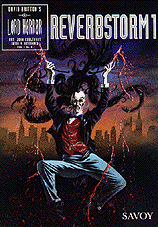References in Reverbstorm 1 (Page numbers refer to pages of drawn artwork in the comic proper, not the opening pages of text and photographs.) P.1 (Silhouette of Lord Horror facing page of Reverbstorm song lyrics) Quote from John Bunyan's Pilgrim's Progress, like Finnegans Wake, another dream narrative. P.2 Descent into the unconscious via 'The Hanged Man' Tarot card. The real William Joyce/Lord Haw-Haw was the last man in England to be hanged as a traitor in 1946. Also, inThe Waste Land, line 55: 'The Hanged Man. Fear death by water.' P.6 Sign on the wall 'No Exit' is part of the recurrent Heaven/Hell imagery, 'No Exit' being the English title of Jean Paul Sartre's play Huit Clos, where 'Hell is other people'. The 'Z' is a motif carried over from Hard Core Horror #5, where it signified various terminations: Zyklon B, zero. P.7 Panel One Words from Finnegans Wake. P.7 Panel Two Jessie Matthew's dream world: Sunday Afternoon On The Island Of La Grande Jatte (1886) by Georges Seurat. The innocent world prior to the century of Modernism, chaos and genocide. Jessie's connection is through Stephen Sondheim's musical Sunday In The Park With George which takes Seurat's painting as its central image. P.9 Words from Finnegans Wake. P.10 Panel Two Horror invades Jessie's dream world. 'Shadows fall' reverses the reassurances in the Reverbstorm lyrics. P.10 Panel Three 'Chromolume' was the term Seurat used to describe any cluster of pointillist dots creating a colour in one of his paintings. In the Sondheim musical, it is the name of a light sculpture created by a contemporary artist. The shape of this light sculpture is the basis for Blue Blaze Laudanum's tower block in Reverbstorm. P.10 Panel Four 'Egnaro' ('orange' reversed) is the mysterious country in the story of the same name by M John Harrison. The central character, 'Lucas', is based on David Britton. 'profondo rosso' is Italian for 'deep red'. P.12 Panel One The picture of the elephant indicates Horror's and Jessie's location as being the Hotel Elephant, a favourite hotel of Adolf Hitler. A reference to the hotel also occurs in Our Lord Of Fuck Off, the text story in this issue ('No pigmy entered the Hotel Elephant in his company'). It also relates to the apes and assorted jungle imagery. P.13 The building with globe and searchlights is Blue Blaze Laudanum's 'Chromolume'. P.14 Panel One Words from Finnegans Wake. P.14 Panels Two & Three Figures from 'Saltimbanques' (1905) by Picasso. The Picasso theme begins (Lord Horror's leitmotiv) commencing with his early works. P.15 Words from Finnegans Wake. P.16 / 17 The beast-headed reporters are a reference to the beast masks drawn by James Cawthorn in the Savoy 'Hawkmoon' books. In the Lord Horror novel, Hitler philosophises about the nature of black and white art and considers four artists: Aubrey Beardsley, Harry Clarke, Burne Hogarth and James Cawthorn. All these artists are referred to directly in the course of Reverbstorm. P.17 Last panel Opening words from Sunday In The Park With George. P.18 / 19 The large centre panel shows an arrangement of phrases from the Sondheim musical over Seurat's painting. P.18 Panel Two Jessie is posing as the woman in Seurat's painting Jeune Femme se Poudrant (1890), as does the character of Dot in the Sondheim musical. P.19 Last panel The first appearance of Humpty Dumpty, a key figure in Finnegans Wake and explainer of riddles in Alice Through The Looking Glass (another dream narrative). P.21 James Joyce appears in the audience, along with the omnipresent background radiation from Finnegans Wake. Here the words have been processed in the manner of A Humument by artist Tom Phillips. Phillips took a forgotten Victorian novel, A Human Document by William Hurrell Mallock, and drew over each page of the book, leaving selected words visible, creating a new work from the original text. With the appearance of Joyce, the three main characters and their leitmotivs are established: Lord Horror—Picasso
Jessie Matthews—Seurat
James Joyce—Finnegans Wake P.22 / 23 Lyrics from Teddy Boy Boogie by rockabilly band Crazy Cavan. P.24 This page is a drawing by Kris based on a cover of Union Jack, a pulp maqazine of the late 20s/early 30s. Picture shows Lord Horror as Zenith the Albino, Anthony Skene's vivid character from the Sexton Blake stories. Michael Moorcock partly based the character of Elric on Zenith. Since Horror is based in part on Elric this brings the genealogy full circle. P.26 Words and music score from Sondheim. More words from Finnegans Wake. P.30 Words from Finnegans Wake. P.31 Lyrics from Sondheim. In the top-right panel Blue Blaze Laudanum her makes first appearance (upside-down). This panel appears the right way up on Page 4 of Reverbstorm #5. P.32/33 The inspiration for the souls comes in part from William Hope Hodgson's The Night Land (1912), and therefore indirectly from Pilgrim's Progress (Hodgson's book being influenced by Bunyan); this ties in further with the Bunyan quote which opens the series. Key literary references later in the series all refer to souls: Ulysses makes much of the Greek idea of metempsychosis, the transmigration of souls; Eliot's The Waste Land and The Hollow Men deal with the soulless, spiritually derelict nature of the Twentieth Century. David Lindsay's A Voyage To Arcturus (1920), to which Reverbstorm is in part dedicated, is another spiritual journey, presented in the guise of generic fantasy. Text story Our Lord Of Fuck Off The last line of the story was its inspiration. The line is a slight alteration from a line of Melville's in Moby Dick—'And Fancy was not on any map; true places never are.'
| 